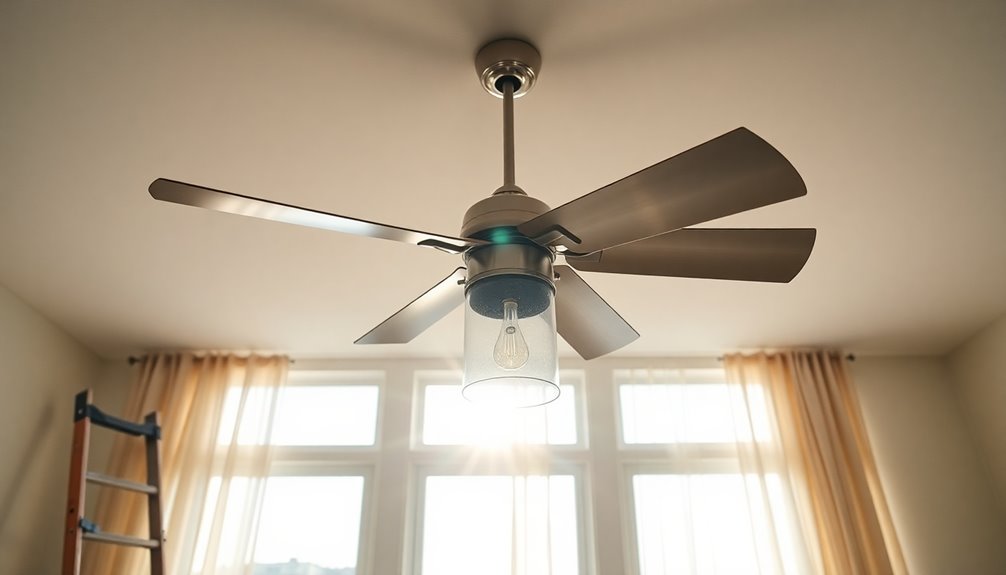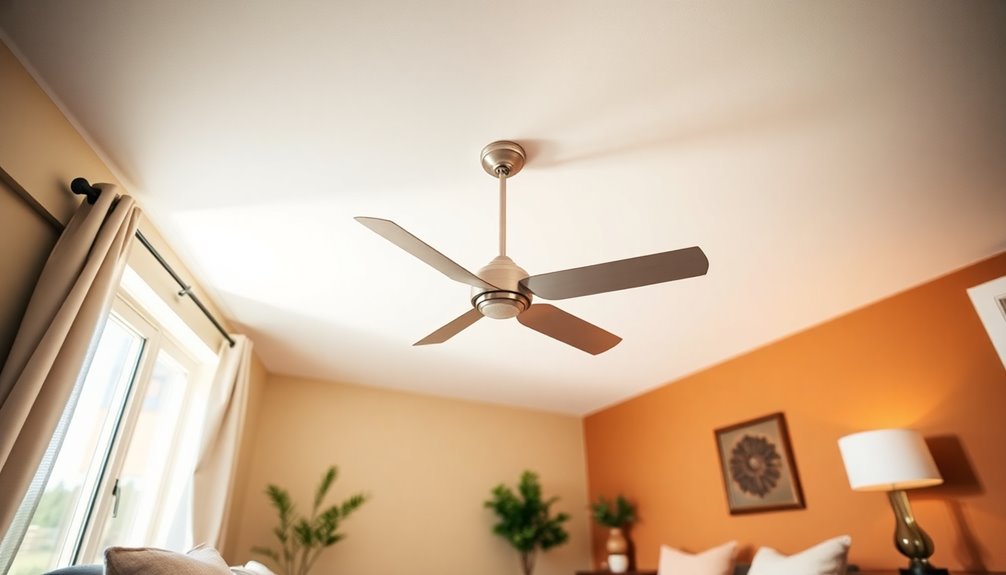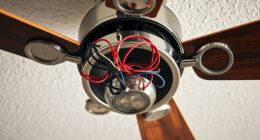If your ceiling fan light is flickering, it could be due to a few common issues. First, check if the bulbs are securely tightened, as loose connections can cause flickering. It's also important to guarantee you're using compatible bulbs and fixtures. Aging wall switches or degraded wiring might also disrupt the electrical flow. Additionally, power fluctuations or overloaded circuits can lead to this problem. If the flickering persists, it might be wise to consult a professional for a thorough inspection. Keep exploring to get insights on simple troubleshooting steps and maintenance tips.
Key Takeaways
- Loose wire connections or degraded switches can interrupt electrical flow, causing flickering lights in ceiling fans.
- Ensure bulbs are securely tightened, as loose bulbs often lead to inconsistent lighting.
- Incompatible dimmer switches, especially with LED bulbs, can disrupt electrical flow and cause flickering.
- Regularly inspect wiring and connections within the fan assembly for signs of damage or wear.
- Power fluctuations from utility providers or overloaded circuits can also result in temporary flickering of ceiling fan lights.
Common Causes of Flickering Lights

When you notice your ceiling fan light flickering, it's often due to a few common culprits. A loose wire connection can easily cause inconsistent electrical contact, especially with vibrations from the fan. Check your bulbs; if they're not screwed in tightly, they might be the reason for the flickering.
Another factor could be the type of light switch you're using. If you have an incompatible dimmer switch, particularly with LED or fluorescent bulbs, it can disrupt the electrical flow, leading to flickering. You should also inspect your wall switches, as they can degrade over time, causing interruptions in the electrical supply.
Don't forget about the bulbs themselves. Mixing different types or using incorrect wattage can create overload issues, affecting the lighting performance.
Regularly inspecting the wiring connections within the fan assembly can help you identify any loose or damaged connections that might be contributing to the problem. By addressing these common causes, you can often resolve the flickering issue and enjoy consistent lighting from your ceiling fan.
Electrical Component Issues

If your ceiling fan lights are flickering, it might be due to loose wiring connections or faulty switches.
These issues can create inconsistent power flow, leading to frustrating flickering.
Regularly checking these electrical components can help you catch problems before they worsen.
Loose Wiring Connections
Loose wiring connections in your ceiling fan can create frustrating flickering lights that disrupt your comfort. When the wiring isn't secure, the flow of electricity becomes intermittent, causing your lights to flicker.
Over time, the vibrations from the fan can lead to these connections loosening, particularly in the wiring harness or within the fan's canopy. This common issue can be easily overlooked but can greatly affect your ceiling fan's performance.
To address this, it's crucial to inspect and tighten all wiring connections within the ceiling fan assembly. A simple check can often resolve those annoying flickering lights caused by loose wiring connections.
Additionally, if the wiring is faulty or degraded, it could create arcing, posing not just a flickering issue but also a fire hazard if left unaddressed. Regular maintenance checks on your ceiling fan's electrical components can help prevent loose wiring from becoming a persistent problem, ensuring stable light performance. Moreover, ensuring your ceiling fan is properly installed with the correct downrod length can enhance its overall efficiency and reduce potential wiring issues.
Faulty Switches and Fuses
Faulty switches and blown fuses can also be significant culprits behind flickering lights in your ceiling fan. Over time, faulty switches can degrade, leading to arcing or intermittent connections that disrupt the electrical flow. This inconsistency often manifests as flickering lights when you operate the fan.
Additionally, if the circuit board within the fan has issues, it can further exacerbate the problem by preventing a steady flow of electricity to the light.
Blown fuses are another common issue that can contribute to erratic lighting. When fuses malfunction or blow, they may cut off power to your ceiling fan lights, causing them to flicker or fail altogether.
Loose wiring connections within the fan assembly can also lead to similar problems, creating those frustrating intermittent connections.
Finally, overheating electrical connections can signal a need for immediate inspection. If you notice flickering lights, it's crucial to check the switches and fuses.
Addressing these faulty switches and blown fuses promptly can help restore consistent illumination and guarantee your ceiling fan operates smoothly. Don't ignore the signs; they could lead to bigger issues down the line.
Bulb Types and Compatibility

When it comes to ceiling fans, choosing the right bulb type can make or break your lighting experience. Different bulbs like incandescent, CFL, and LED have varying compatibility with ceiling fans, which can directly affect their performance and flickering behavior.
LED bulbs are energy-efficient but may require specific dimmer switches to function properly. If you use incompatible dimmers, you might notice annoying flickering.
On the other hand, incandescent bulbs are generally more reliable. However, they can still flicker if they're loosely connected or if their wattage exceeds the fan's specifications.
Mixing different bulb types in the same fixture can lead to inconsistent lighting, as each type reacts differently to voltage fluctuations.
To avoid these issues, verify that the bulbs you choose match your ceiling fan's wattage and compatibility requirements. By doing so, you can help prevent flickering and enhance your overall lighting performance.
Troubleshooting Steps

To fix the flickering lights on your ceiling fan, start by checking all the bulb connections to make sure they're secure.
Next, inspect the wiring for any issues that could be causing the problem.
These steps can help you identify and resolve the flickering quickly.
Check Bulb Connections
A ceiling fan's light flickering can often be traced back to loose bulb connections. To tackle this issue, follow these steps to guarantee your ceiling fan lights shine steadily:
- Turn Off Power: Start by switching off the fan and light to avoid any electrical hazards.
- Inspect Bulb Connections: Check each bulb to guarantee it's securely tightened in its socket. Loose connections can easily cause flickering.
- Examine Socket Condition: Look for dirt or corrosion in the bulb sockets. Any debris can disrupt a good electrical connection, leading to flickering.
- Test Bulbs Elsewhere: If you've tightened the bulbs and flickering persists, try using the bulbs in a different fixture. This helps rule out any faulty bulbs causing the issue.
Regularly checking these bulb connections can enhance the performance of your ceiling fan lights and prevent flickering from becoming a recurring problem.
Inspect Wiring Issues
Inspecting wiring issues is essential for verifying your ceiling fan lights operate without flickering. Start by checking all wiring connections within the ceiling fan assembly. Loose wires can disrupt power flow and lead to flickering light. Look closely at the wiring harness connected to the light kit. If you spot any frayed or broken wires, that could cause intermittent connections and contribute to the flickering.
Next, verify the wiring connections in the wiring canopy are secure. Make sure the factory wiring strips are long enough to maintain a stable connection; inadequate strips can lead to issues. Also, be on the lookout for any signs of overheating at electrical connections. Overheating typically indicates poor contact and can result in temporary lighting failures.
If you've inspected everything and the flickering persists, consider testing the fan with a different circuit. You can temporarily wire the light kit to another circuit using an extension cord. This step will help you determine if the problem lies within the original circuit or the fan itself.
Taking these steps will help you identify and resolve any wiring issues affecting your ceiling fan lights.
Maintenance and Prevention

Maintaining your ceiling fan's light to prevent flickering is critical for both functionality and ambiance. By following these maintenance tips, you can enjoy a steady light and prolong the life of your fan:
- Regularly check and tighten light bulbs: Loose bulbs can vibrate and cause flickering, so be sure to secure them properly.
- Upgrade to compatible dimmer switches: If you're using dimmable LED bulbs, make sure your dimmer switch is compatible to avoid flickering issues.
- Schedule periodic inspections: Examine the electrical components of your ceiling fan regularly to catch any wear or damage early on. Additionally, ensure that any electrical components are free from high humidity which can affect performance.
- Use manufacturer-recommended bulbs: Stick to the bulbs suggested by the fan's manufacturer to guarantee compatibility and peak performance.
Also, consider installing surge protectors to shield your fan's lighting system from electrical spikes. Additionally, maintaining proper airflow can help reduce strain on the electrical components, potentially preventing flickering.
Impact of Remote Controls

When using a ceiling fan with remote control capabilities, you might encounter flickering lights due to several factors that can disrupt the signal. Understanding these issues can help you resolve the problem.
| Factor | Description | Solution |
|---|---|---|
| Signal Interference | Other devices may disrupt your remote control signal, leading to light flicker. | Keep the fan away from potential interference sources. |
| Weak Batteries | Dead or weak batteries in your remote may cause inconsistent signals, resulting in flickering lights. | Replace the remote control batteries regularly. |
| Improper Pairing | If your remote isn't correctly paired with the fan, it can create communication conflicts. | Confirm the remote is properly paired with your fan. |
Obstructions can also interfere with the signal, so make certain there's a clear line of sight between the remote control and the fan. Finally, multiple remote controls nearby can confuse your ceiling fan, causing erratic light behavior. By addressing these factors, you can minimize the chances of light flicker and enjoy a more stable ceiling fan experience.
Circuit and Power Management

A flickering ceiling fan light can often signal issues with your circuit and power management. If you've noticed this, consider the following potential causes:
- Overloaded Circuits: Running multiple high-demand appliances simultaneously can lead to voltage drops, causing flickering lights.
- Peak Usage Times: Flickering may worsen during peak hours when the electrical load is high, indicating that your circuit capacity is being exceeded.
- Power Fluctuations: Temporary outages or fluctuations from your power company can also manifest as flickering lights; these often resolve on their own.
- Appliance Distribution: Poor distribution of electrical load among circuits might exacerbate the issue, necessitating reevaluation.
To alleviate flickering caused by overloaded circuits, you might need to install additional circuits or redistribute your electrical load.
Consulting with a licensed Electrical Contractor can provide valuable insights into your circuit management and help address persistent flickering issues. They can assess your situation and recommend appropriate solutions.
Fan and Motor Functionality

Issues with fan and motor functionality can often lead to ceiling fan light flickering. A malfunctioning fan motor may create electrical interference, especially if it's overheating or nearing failure. As the motor ages, wear and tear can affect its ability to deliver consistent power to the connected light fixture, resulting in that annoying flicker.
Additionally, if your fan blades are imbalanced, they can create vibrations that disrupt the stability of the light fixture, causing flickering or even strobing effects.
It's also essential to make certain your fan motor is adequately lubricated; a lack of lubrication can strain the system, making it difficult for the motor to operate smoothly, which may lead to flickering lights.
Environmental factors can play a role too. High humidity and fluctuating temperatures can negatively impact both the fan motor's functionality and the performance of your light fixture.
Expert Insights and Advice

Ceiling fans can bring comfort and light to your space, but flickering lights can quickly turn that comfort into frustration. Understanding the root causes can help you tackle these issues effectively. Here are some expert insights:
- Check bulb connections: Verify all bulbs are securely tightened; loose connections often lead to flickering lights.
- Avoid incompatible dimmers: If you're using LED bulbs, make certain your dimmer switch is compatible. Using the wrong dimmer can cause flickering.
- Inspect wiring: Look for any signs of faulty wiring or overloaded circuits. These electrical issues can disrupt the power supply and cause your lights to flicker.
- Schedule regular maintenance: Regular checks on connections and compatibility of electrical components can prevent future flickering.
If you've tried these tips and the flickering persists, it's wise to consult a licensed electrician. They can accurately diagnose any underlying electrical issues and help restore the comfort and illumination of your ceiling fan.
Don't let flickering lights dim your space—take action today!
Frequently Asked Questions
How Do I Stop My Ceiling Fan Lights From Flickering?
To stop your ceiling fan lights from flickering, start by checking and tightening all bulb connections.
Make certain the bulbs are secure. Next, inspect any dimmer switches to verify they're compatible with your bulbs.
Test each bulb individually for faults and replace any that are defective.
Finally, check the wiring connections within the fan for looseness or damage.
If issues persist, consider calling a licensed electrician for a thorough assessment.
How Do I Stop My Ceiling Lights From Flickering?
To stop your ceiling lights from flickering, start by checking the bulb connections. Make sure they're tightly fitted; loose bulbs can cause flickering.
Next, inspect your dimmer switches if you're using dimmable bulbs, as incompatibility can lead to issues.
Test each bulb individually to spot any faulty ones.
Finally, check the wiring in the fixture for any loose connections.
If problems persist, consider consulting a professional electrician for further assistance.
Are Ceiling Lights Flickering a Fire Hazard?
Yes, flickering ceiling lights can be a fire hazard.
You should check for loose wiring, overloaded circuits, or incompatible bulbs, as these issues can lead to overheating and potential fires.
If you notice flickering, it's essential to address it promptly to prevent electrical failures.
Regular maintenance of your electrical components can help you catch problems early.
Ignoring flickering lights might lead to serious safety risks, so stay vigilant and take action when necessary.
How to Fix a Flickering LED Light?
Imagine your room dancing in shadows, the flickering LED light creating an eerie atmosphere.
To fix this, start by tightening any loose bulbs in their sockets. Check if your dimmer switch matches the bulbs; incompatibility can cause flickering.
Inspect the wiring for any damage, and if you find faulty bulbs, replace them with high-quality options.
If the problem continues, it's wise to call an electrician to check for deeper electrical issues.
Conclusion
In the dance of light and shadow, a flickering ceiling fan light can be more than just a nuisance; it's a whisper of underlying issues. By addressing the common causes, from electrical quirks to bulb mismatches, you can restore harmony to your space. Keep up with regular maintenance, and you'll guarantee your fan and its glow keep spinning smoothly. So, take a moment to troubleshoot and let your ceiling fan shine bright like a star in a clear night sky.









